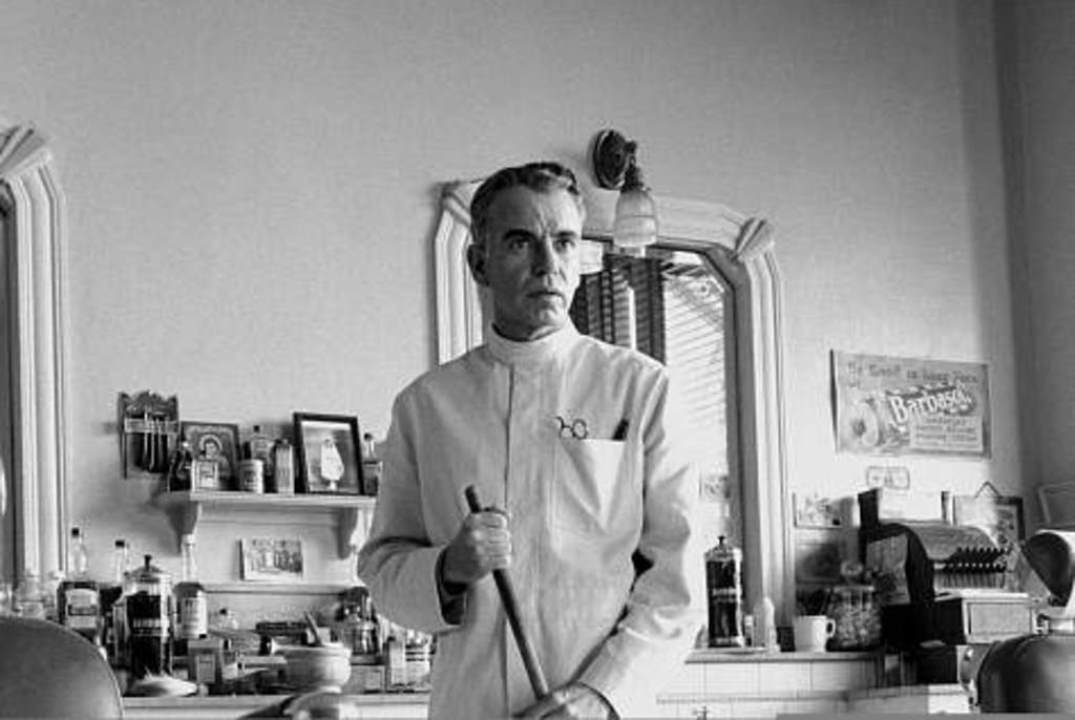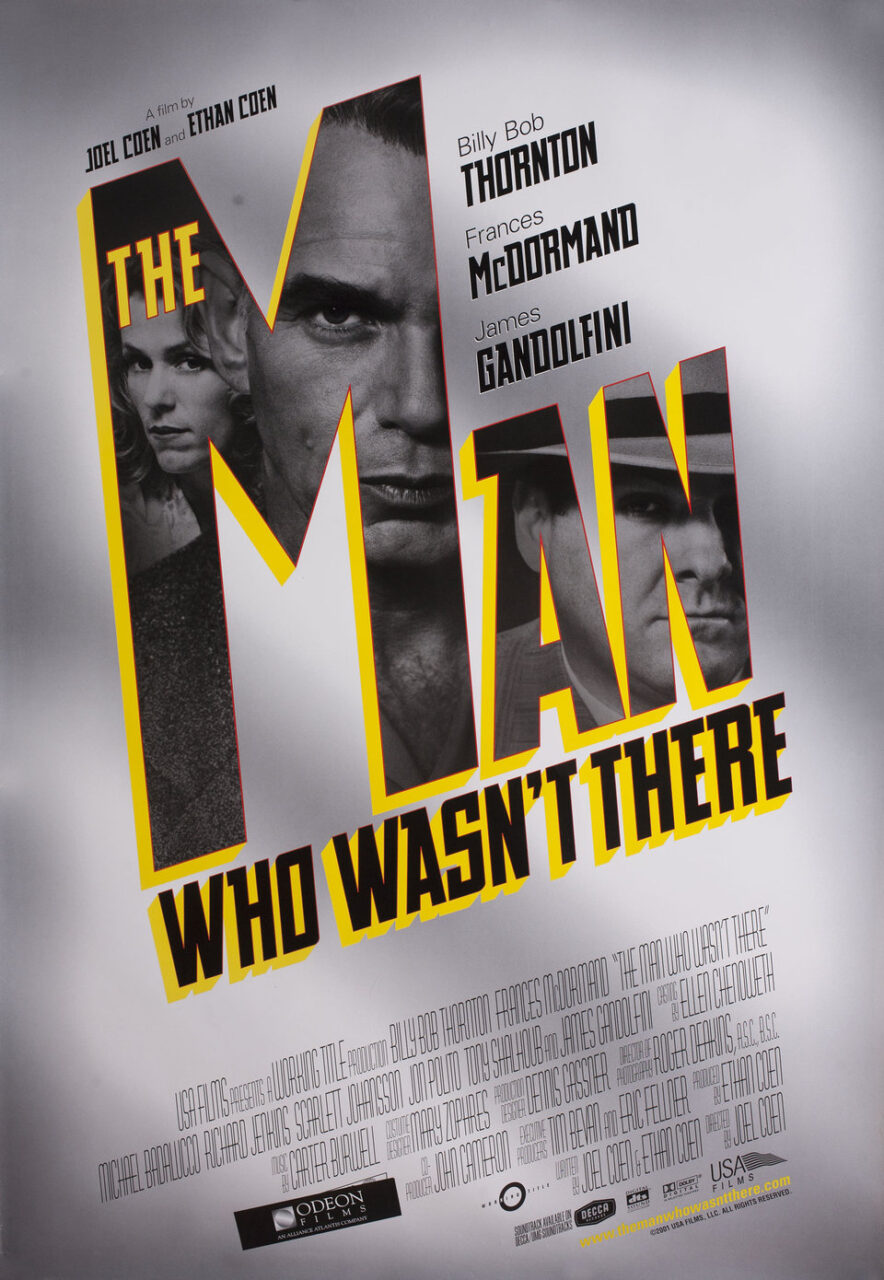Crew
Director – Joel Coen, Screenplay – Ethan Coen & Joel Coen, Producers – Ethan Coen, Tim Bevan & Eric Fellner, Photography (b&w) – Roger Deakins, Music – Carter Burwell, Visual Effects Supervisor – Janek Sirrs, Visual Effects – MVFX, Special Effects Supervisor – Peter Chesney, Makeup Effects – Make-Up and Monsters, Production Design – Dennis Gassner. Production Company – Working Title.
Cast
Billy Bob Thornton (Ed Crane), Frances McDormand (Doris Crane), Michael Badalucco (Frank Rumpole), James Gandolfini (Big Dave Brewster), Tony Shalhoub (Freddy Reidenschneider), Jon Polito (Creighton Tolliver), Scarlett Johansson (Rachel ‘Birdie’ Abundas), Richard Jenkins (Walter Abundas), Katherine Borovitz (Ann Nirdlinger)
Plot
Santa Rosa, 1949. Ed Crane is a mild-mannered barber who rarely speaks. He sees an opportunity when salesman Creighton Tolliver comes to him for a haircut and talks about wanting to set up a chain of dry-cleaning stores, but says that he needs $10,000 to do so. Ed decides to get the $10,000 by sending an anonymous blackmail note to Big Dave Brewster who is having an affair with Ed’s wife Doris, threatening to expose the two of them. The plan immediately goes wrong when Dave exposes the scheme and Ed is forced to kill him, only to then have Doris placed on trial for the murder.
The Man Who Wasn’t There, which is no relation to the extremely bad invisible man comedy The Man Who Wasn’t There (1983), comes from the Coen Brothers. The Coens Brothers have made such films as Blood Simple (1983), Raising Arizona (1987), Barton Fink (1991), The Hudsucker Proxy (1994), Fargo (1996), The Big Lebowski (1998), O Brother, Where Art Thou? (2000), No Country for Old Men (2007), Burn After Reading (2008), A Serious Man (2009), True Grit (2010), Inside Llewyn Davis (2013), Hail, Caesar! (2016) and The Ballad of Buster Scruggs (2018).
Although they divide the creative choices between them on the credits – Joel as director, Ethan as producer and both as screenwriters – their roles in actuality are much more blurred with the two acting more as a single creature with two heads. Characteristic of the Coen Brothers’ films is a minatory sense of black humour, a love of 20th Century Americana period settings and a comic ear for the corniness of bygone colloquialisms.
At its most compelling, the Coen Brothers’ make The Man Who Wasn’t There a meditation upon anonymity. The title is almost meant to be taken literally and Billy Bob Thornton gives a performance that is communicated more by his impassively deep wrinkles than it is by the few words of dialogue he ever utters – as he says “I don’t talk much, I just cut the hair.” The film almost seems assembled to kick Billy Bob Thornton in the teeth for doing anything that tries to move him out of his passive anonymity – his desire to buy into what is in all likelihood a confidence scam of a dry-cleaning franchise (naturally as a ‘silent’ partner) and to blackmail his wife and her lover to get the set-up money goes disastrously wrong at every turn, his efforts to save her and then himself in court end up going awry, and his dream of turning Scarlett Johansson into a piano prodigy ends up a shattered illusion.

Even the ending where he goes off to his execution with the hope of communicating the things he never could find the words to in this life to his wife who was unfaithful and regarded him as a chump seem equally deluded. When lawyer Tony Shalhoub swings an existential argument in the courtroom that refers to Billy Bob as the quintessence of Modern Man, it is a reference that can surely only be ironic – one that equates an existential lack of identity with grey anonymity.
For all that, The Man Who Wasn’t There seems far less Coen-esque than their previous films. There is certainly the period setting of post-War middle class Americana but, with O Brother, Where Art Thou? and this, the Coen Brothers’ seem to be softening and becoming somewhat warmer (or more to the point less cruel) toward their character – Billy Bob Thornton’s character is an anonymous nobody whose every attempt to do something ends in disaster and a shattering of expectation but the Coens’ are far less cruel to him than they were to say John Turturro in Barton Fink, Tim Robbins in The Hudsucker Proxy or Jeff Bridges in The Big Lebowski. Nor does the film turn with the blackly cruel twists that one expects with the Coens Brothers present. Nor does it light up with their dark humour, only in an occasional few scenes – especially whenever Tony Shalhoub’s lawyer is on screen.
For reasons unclear, the Coens’ also throw in part of that era’s fascination with flying saucers (the reason for the film’s inclusion here). James Gandolfini’s wife has a weird soliloquy about how he was abducted by flying saucers; following the crash, a spinning hubcap metamorphoses into a flying saucer that seems to offer a brief glimpse of an alternate version of things where Billy Bob Thornton is reunited with wife Frances McDormand again; and near the end the Coens’ finally grant us a vision of a flying saucer hovering over the prison in what is maybe a dream where Billy Bob Thornton is simply allowed to walk out of his cell. Quite what this has to do with the rest of the film could be anybody’s guess.
Trailer here


